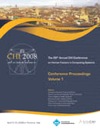CHI 2008: a selection on mobile banking
(Papers are linked to their pdf downloads, if available.)
From meiwaku to tokushita!: lessons for digital money design from Japan [abstract]
Authors: Scott Mainwaring (Intel Research), Wendy March (Intel Research) and Bill Maurer (UC Irvine)
Abstract: Based on ethnographically-inspired research in Japan, we report on people’s experiences using digital money payment systems that use Sony’s FeliCa near-field communication smartcard technology. As an example of ubiquitous computing in the here and now, the adoption of digital money is found to be messy and contingent, shot through with cultural and social factors that do not hinder this adoption but rather constitute its specific character. Adoption is strongly tied to Japanese conceptions of the aesthetic and moral virtue of smooth flow and avoidance of commotion, as well as the excitement at winning something for nothing. Implications for design of mobile payment systems stress the need to produce open-ended platforms that can serve as the vehicle for multiple meanings and experiences without foreclosing such possibilities in the name of efficiency.
Human-Currency Interaction: learning from virtual currency use in China [abstract]
Authors: Yang Wang (UC Irvine) and Scott D. Mainwaring (Intel Research)
Abstract: What happens when the domains of HCI design and money intersect? This paper presents analyses from an ethnographic study of virtual currency use in China to discuss implications for game design, and HCI design more broadly. We found that how virtual currency is perceived, obtained, and spent can critically shape gamers’ behavior and experience. Virtual and real currencies can interact in complex ways that promote, extend, and/or interfere with the value and character of game worlds. Bringing money into HCI design heightens existing issues of realness, trust, and fairness, and thus presents new challenges and opportunities for user experience innovation.
UbiPay: conducting everyday payments with Minimum User Involvement [abstract]
Authors: Vili Lehdonvirta (Helsinki Institute for Information Technology), Hayuru Soma (Waseda University), Hitoshi Ito (Waseda University), Hiroaki Kimura (Waseda University) and Tatsuo Nakajima (Waseda University)
Abstract: As services embedded into public spaces become increasingly transparent, one peripheral aspect of use continues to demand explicit user attention: payment. UbiPay is a system that carries out small everyday payments in a way that minimises user involvement by choosing an interaction method based on context information. The aim is to make paying like breathing: something we are only peripherally aware of unless we exert our resources beyond the usual. This has powerful implications for business and design.





[…] weblog ‘Putting people first’ links to three interesting papers from CHI 2008 on mobile […]
[…] something about that.’” Intel scientists have engaged in diverse research projects from digital money to mobile antennas that provide access to cell phone services in developing regions of the world. […]
[…] something about that.’” Intel scientists have engaged in diverse research projects from digital money to mobile antennas that provide access to cell phone services in developing regions of the world. […]